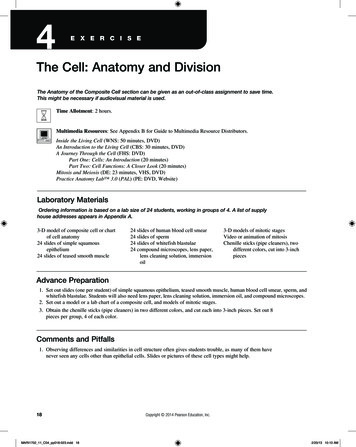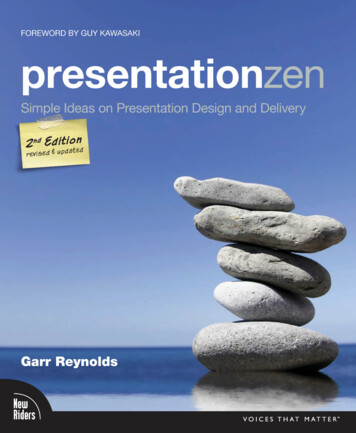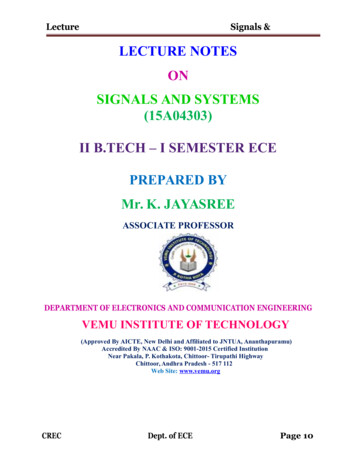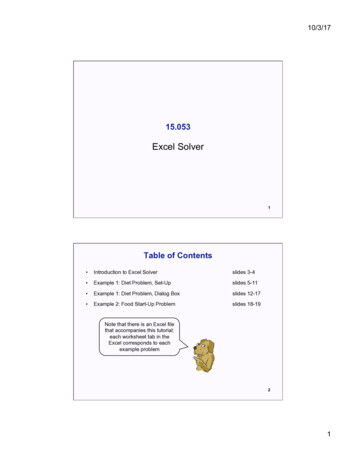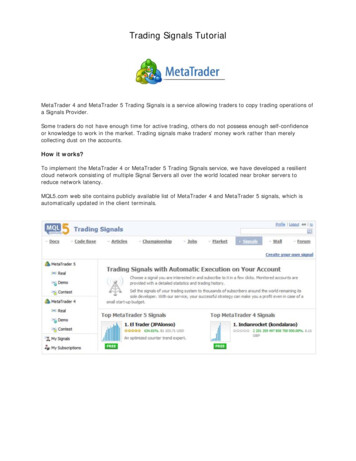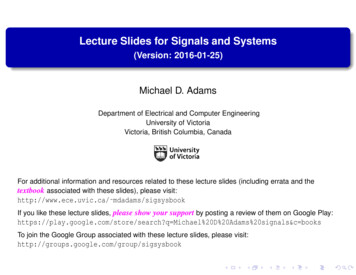
Transcription
Lecture Slides for Signals and Systems(Version: 2016-01-25)Michael D. AdamsDepartment of Electrical and Computer EngineeringUniversity of VictoriaVictoria, British Columbia, CanadaFor additional information and resources related to these lecture slides (including errata and thetextbook associated with these slides), please visit:http://www.ece.uvic.ca/ mdadams/sigsysbookIf you like these lecture slides, please show your support by posting a review of them on Google Play:https://play.google.com/store/search?q Michael%20D%20Adams%20signals&c booksTo join the Google Group associated with these lecture slides, please visit:http://groups.google.com/group/sigsysbook
The author has taken care in the preparation of this document, but makes no expressed or implied warranty of any kind and assumes noresponsibility for errors or omissions. No liability is assumed for incidental or consequential damages in connection with or arising out of the useof the information or programs contained herein.Copyright c 2016 Michael D. AdamsPublished by the University of Victoria, Victoria, British Columbia, CanadaThis document is licensed under a Creative Commons Attribution-NonCommercial-NoDerivs 3.0 Unported (CC BY-NC-ND 3.0) License. A copyof this license can be found on page iii of this document. For a simple explanation of the rights granted by this license, .0/This document was typeset with LATEX.ISBN 978-1-55058-584-1 (paperback)ISBN 978-1-55058-585-8 (PDF)
License ICreative Commons Legal CodeAttribution-NonCommercial-NoDerivs 3.0 UnportedCREATIVE COMMONS CORPORATION IS NOT A LAW FIRM AND DOES NOT PROVIDELEGAL SERVICES. DISTRIBUTION OF THIS LICENSE DOES NOT CREATE ANATTORNEY-CLIENT RELATIONSHIP. CREATIVE COMMONS PROVIDES THISINFORMATION ON AN "AS-IS" BASIS. CREATIVE COMMONS MAKES NO WARRANTIESREGARDING THE INFORMATION PROVIDED, AND DISCLAIMS LIABILITY FORDAMAGES RESULTING FROM ITS USE.LicenseTHE WORK (AS DEFINED BELOW) IS PROVIDED UNDER THECOMMONS PUBLIC LICENSE ("CCPL" OR "LICENSE"). THECOPYRIGHT AND/OR OTHER APPLICABLE LAW. ANY USE OFAUTHORIZED UNDER THIS LICENSE OR COPYRIGHT LAW ISTERMS OF THIS CREATIVEWORK IS PROTECTED BYTHE WORK OTHER THAN ASPROHIBITED.BY EXERCISING ANY RIGHTS TO THE WORK PROVIDED HERE, YOU ACCEPT AND AGREETO BE BOUND BY THE TERMS OF THIS LICENSE. TO THE EXTENT THIS LICENSE MAYBE CONSIDERED TO BE A CONTRACT, THE LICENSOR GRANTS YOU THE RIGHTSCONTAINED HERE IN CONSIDERATION OF YOUR ACCEPTANCE OF SUCH TERMS ANDCONDITIONS.1. Definitionsa. "Adaptation" means a work based upon the Work, or upon the Work andother pre-existing works, such as a translation, adaptation,derivative work, arrangement of music or other alterations of aliterary or artistic work, or phonogram or performance and includescinematographic adaptations or any other form in which the Work may berecast, transformed, or adapted including in any form recognizablyderived from the original, except that a work that constitutes aCollection will not be considered an Adaptation for the purpose ofthis License. For the avoidance of doubt, where the Work is a musicalwork, performance or phonogram, the synchronization of the Work intimed-relation with a moving image ("synching") will be considered anAdaptation for the purpose of this License.b. "Collection" means a collection of literary or artistic works, such asencyclopedias and anthologies, or performances, phonograms orCopyright c 2016 Michael D. AdamsLecture SlidesVersion: 2016-01-25iii
License IIc.d.e.f.broadcasts, or other works or subject matter other than works listedin Section 1(f) below, which, by reason of the selection andarrangement of their contents, constitute intellectual creations, inwhich the Work is included in its entirety in unmodified form alongwith one or more other contributions, each constituting separate andindependent works in themselves, which together are assembled into acollective whole. A work that constitutes a Collection will not beconsidered an Adaptation (as defined above) for the purposes of thisLicense."Distribute" means to make available to the public the original andcopies of the Work through sale or other transfer of ownership."Licensor" means the individual, individuals, entity or entities thatoffer(s) the Work under the terms of this License."Original Author" means, in the case of a literary or artistic work,the individual, individuals, entity or entities who created the Workor if no individual or entity can be identified, the publisher; and inaddition (i) in the case of a performance the actors, singers,musicians, dancers, and other persons who act, sing, deliver, declaim,play in, interpret or otherwise perform literary or artistic works orexpressions of folklore; (ii) in the case of a phonogram the producerbeing the person or legal entity who first fixes the sounds of aperformance or other sounds; and, (iii) in the case of broadcasts, theorganization that transmits the broadcast."Work" means the literary and/or artistic work offered under the termsof this License including without limitation any production in theliterary, scientific and artistic domain, whatever may be the mode orform of its expression including digital form, such as a book,pamphlet and other writing; a lecture, address, sermon or other workof the same nature; a dramatic or dramatico-musical work; achoreographic work or entertainment in dumb show; a musicalcomposition with or without words; a cinematographic work to which areassimilated works expressed by a process analogous to cinematography;a work of drawing, painting, architecture, sculpture, engraving orlithography; a photographic work to which are assimilated worksexpressed by a process analogous to photography; a work of appliedart; an illustration, map, plan, sketch or three-dimensional workrelative to geography, topography, architecture or science; aperformance; a broadcast; a phonogram; a compilation of data to theextent it is protected as a copyrightable work; or a work performed bya variety or circus performer to the extent it is not otherwiseconsidered a literary or artistic work.Copyright c 2016 Michael D. AdamsLecture SlidesVersion: 2016-01-25iv
License IIIg. "You" means an individual or entity exercising rights under thisLicense who has not previously violated the terms of this License withrespect to the Work, or who has received express permission from theLicensor to exercise rights under this License despite a previousviolation.h. "Publicly Perform" means to perform public recitations of the Work andto communicate to the public those public recitations, by any means orprocess, including by wire or wireless means or public digitalperformances; to make available to the public Works in such a way thatmembers of the public may access these Works from a place and at aplace individually chosen by them; to perform the Work to the publicby any means or process and the communication to the public of theperformances of the Work, including by public digital performance; tobroadcast and rebroadcast the Work by any means including signs,sounds or images.i. "Reproduce" means to make copies of the Work by any means includingwithout limitation by sound or visual recordings and the right offixation and reproducing fixations of the Work, including storage of aprotected performance or phonogram in digital form or other electronicmedium.2. Fair Dealing Rights. Nothing in this License is intended to reduce,limit, or restrict any uses free from copyright or rights arising fromlimitations or exceptions that are provided for in connection with thecopyright protection under copyright law or other applicable laws.3. License Grant. Subject to the terms and conditions of this License,Licensor hereby grants You a worldwide, royalty-free, non-exclusive,perpetual (for the duration of the applicable copyright) license toexercise the rights in the Work as stated below:a. to Reproduce the Work, to incorporate the Work into one or moreCollections, and to Reproduce the Work as incorporated in theCollections; and,b. to Distribute and Publicly Perform the Work including as incorporatedin Collections.The above rights may be exercised in all media and formats whether nowknown or hereafter devised. The above rights include the right to makesuch modifications as are technically necessary to exercise the rights inother media and formats, but otherwise you have no rights to makeCopyright c 2016 Michael D. AdamsLecture SlidesVersion: 2016-01-25v
License IVAdaptations. Subject to 8(f), all rights not expressly granted by Licensorare hereby reserved, including but not limited to the rights set forth inSection 4(d).4. Restrictions. The license granted in Section 3 above is expressly madesubject to and limited by the following restrictions:a. You may Distribute or Publicly Perform the Work only under the termsof this License. You must include a copy of, or the Uniform ResourceIdentifier (URI) for, this License with every copy of the Work YouDistribute or Publicly Perform. You may not offer or impose any termson the Work that restrict the terms of this License or the ability ofthe recipient of the Work to exercise the rights granted to thatrecipient under the terms of the License. You may not sublicense theWork. You must keep intact all notices that refer to this License andto the disclaimer of warranties with every copy of the Work YouDistribute or Publicly Perform. When You Distribute or PubliclyPerform the Work, You may not impose any effective technologicalmeasures on the Work that restrict the ability of a recipient of theWork from You to exercise the rights granted to that recipient underthe terms of the License. This Section 4(a) applies to the Work asincorporated in a Collection, but this does not require the Collectionapart from the Work itself to be made subject to the terms of thisLicense. If You create a Collection, upon notice from any Licensor Youmust, to the extent practicable, remove from the Collection any creditas required by Section 4(c), as requested.b. You may not exercise any of the rights granted to You in Section 3above in any manner that is primarily intended for or directed towardcommercial advantage or private monetary compensation. The exchange ofthe Work for other copyrighted works by means of digital file-sharingor otherwise shall not be considered to be intended for or directedtoward commercial advantage or private monetary compensation, providedthere is no payment of any monetary compensation in connection withthe exchange of copyrighted works.c. If You Distribute, or Publicly Perform the Work or Collections, Youmust, unless a request has been made pursuant to Section 4(a), keepintact all copyright notices for the Work and provide, reasonable tothe medium or means You are utilizing: (i) the name of the OriginalAuthor (or pseudonym, if applicable) if supplied, and/or if theOriginal Author and/or Licensor designate another party or parties(e.g., a sponsor institute, publishing entity, journal) forCopyright c 2016 Michael D. AdamsLecture SlidesVersion: 2016-01-25vi
License Vattribution ("Attribution Parties") in Licensor’s copyright notice,terms of service or by other reasonable means, the name of such partyor parties; (ii) the title of the Work if supplied; (iii) to theextent reasonably practicable, the URI, if any, that Licensorspecifies to be associated with the Work, unless such URI does notrefer to the copyright notice or licensing information for the Work.The credit required by this Section 4(c) may be implemented in anyreasonable manner; provided, however, that in the case of aCollection, at a minimum such credit will appear, if a credit for allcontributing authors of Collection appears, then as part of thesecredits and in a manner at least as prominent as the credits for theother contributing authors. For the avoidance of doubt, You may onlyuse the credit required by this Section for the purpose of attributionin the manner set out above and, by exercising Your rights under thisLicense, You may not implicitly or explicitly assert or imply anyconnection with, sponsorship or endorsement by the Original Author,Licensor and/or Attribution Parties, as appropriate, of You or Youruse of the Work, without the separate, express prior writtenpermission of the Original Author, Licensor and/or AttributionParties.d. For the avoidance of doubt:i. Non-waivable Compulsory License Schemes. In those jurisdictions inwhich the right to collect royalties through any statutory orcompulsory licensing scheme cannot be waived, the Licensorreserves the exclusive right to collect such royalties for anyexercise by You of the rights granted under this License;ii. Waivable Compulsory License Schemes. In those jurisdictions inwhich the right to collect royalties through any statutory orcompulsory licensing scheme can be waived, the Licensor reservesthe exclusive right to collect such royalties for any exercise byYou of the rights granted under this License if Your exercise ofsuch rights is for a purpose or use which is otherwise thannoncommercial as permitted under Section 4(b) and otherwise waivesthe right to collect royalties through any statutory or compulsorylicensing scheme; and,iii. Voluntary License Schemes. The Licensor reserves the right tocollect royalties, whether individually or, in the event that theLicensor is a member of a collecting society that administersvoluntary licensing schemes, via that society, from any exerciseby You of the rights granted under this License that is for aCopyright c 2016 Michael D. AdamsLecture SlidesVersion: 2016-01-25vii
License VIpurpose or use which is otherwise than noncommercial as permittedunder Section 4(b).e. Except as otherwise agreed in writing by the Licensor or as may beotherwise permitted by applicable law, if You Reproduce, Distribute orPublicly Perform the Work either by itself or as part of anyCollections, You must not distort, mutilate, modify or take otherderogatory action in relation to the Work which would be prejudicialto the Original Author’s honor or reputation.5. Representations, Warranties and DisclaimerUNLESS OTHERWISE MUTUALLY AGREED BY THE PARTIES IN WRITING, LICENSOROFFERS THE WORK AS-IS AND MAKES NO REPRESENTATIONS OR WARRANTIES OF ANYKIND CONCERNING THE WORK, EXPRESS, IMPLIED, STATUTORY OR OTHERWISE,INCLUDING, WITHOUT LIMITATION, WARRANTIES OF TITLE, MERCHANTIBILITY,FITNESS FOR A PARTICULAR PURPOSE, NONINFRINGEMENT, OR THE ABSENCE OFLATENT OR OTHER DEFECTS, ACCURACY, OR THE PRESENCE OF ABSENCE OF ERRORS,WHETHER OR NOT DISCOVERABLE. SOME JURISDICTIONS DO NOT ALLOW THE EXCLUSIONOF IMPLIED WARRANTIES, SO SUCH EXCLUSION MAY NOT APPLY TO YOU.6. Limitation on Liability. EXCEPT TO THE EXTENT REQUIRED BY APPLICABLELAW, IN NO EVENT WILL LICENSOR BE LIABLE TO YOU ON ANY LEGAL THEORY FORANY SPECIAL, INCIDENTAL, CONSEQUENTIAL, PUNITIVE OR EXEMPLARY DAMAGESARISING OUT OF THIS LICENSE OR THE USE OF THE WORK, EVEN IF LICENSOR HASBEEN ADVISED OF THE POSSIBILITY OF SUCH DAMAGES.7. Terminationa. This License and the rights granted hereunder will terminateautomatically upon any breach by You of the terms of this License.Individuals or entities who have received Collections from You underthis License, however, will not have their licenses terminatedprovided such individuals or entities remain in full compliance withthose licenses. Sections 1, 2, 5, 6, 7, and 8 will survive anytermination of this License.b. Subject to the above terms and conditions, the license granted here isperpetual (for the duration of the applicable copyright in the Work).Notwithstanding the above, Licensor reserves the right to release theWork under different license terms or to stop distributing the Work atany time; provided, however that any such election will not serve towithdraw this License (or any other license that has been, or isCopyright c 2016 Michael D. AdamsLecture SlidesVersion: 2016-01-25viii
License VIIrequired to be, granted under the terms of this License), and thisLicense will continue in full force and effect unless terminated asstated above.8. Miscellaneousa. Each time You Distribute or Publicly Perform the Work or a Collection,the Licensor offers to the recipient a license to the Work on the sameterms and conditions as the license granted to You under this License.b. If any provision of this License is invalid or unenforceable underapplicable law, it shall not affect the validity or enforceability ofthe remainder of the terms of this License, and without further actionby the parties to this agreement, such provision shall be reformed tothe minimum extent necessary to make such provision valid andenforceable.c. No term or provision of this License shall be deemed waived and nobreach consented to unless such waiver or consent shall be in writingand signed by the party to be charged with such waiver or consent.d. This License constitutes the entire agreement between the parties withrespect to the Work licensed here. There are no understandings,agreements or representations with respect to the Work not specifiedhere. Licensor shall not be bound by any additional provisions thatmay appear in any communication from You. This License may not bemodified without the mutual written agreement of the Licensor and You.e. The rights granted under, and the subject matter referenced, in thisLicense were drafted utilizing the terminology of the Berne Conventionfor the Protection of Literary and Artistic Works (as amended onSeptember 28, 1979), the Rome Convention of 1961, the WIPO CopyrightTreaty of 1996, the WIPO Performances and Phonograms Treaty of 1996and the Universal Copyright Convention (as revised on July 24, 1971).These rights and subject matter take effect in the relevantjurisdiction in which the License terms are sought to be enforcedaccording to the corresponding provisions of the implementation ofthose treaty provisions in the applicable national law. If thestandard suite of rights granted under applicable copyright lawincludes additional rights not granted under this License, suchadditional rights are deemed to be included in the License; thisLicense is not intended to restrict the license of any rights underapplicable law.Copyright c 2016 Michael D. AdamsLecture SlidesVersion: 2016-01-25ix
License VIIICreative Commons NoticeCreative Commons is not a party to this License, and makes no warrantywhatsoever in connection with the Work. Creative Commons will not beliable to You or any party on any legal theory for any damageswhatsoever, including without limitation any general, special,incidental or consequential damages arising in connection to thislicense. Notwithstanding the foregoing two (2) sentences, if CreativeCommons has expressly identified itself as the Licensor hereunder, itshall have all rights and obligations of Licensor.Except for the limited purpose of indicating to the public that theWork is licensed under the CCPL, Creative Commons does not authorizethe use by either party of the trademark "Creative Commons" or anyrelated trademark or logo of Creative Commons without the priorwritten consent of Creative Commons. Any permitted use will be incompliance with Creative Commons’ then-current trademark usageguidelines, as may be published on its website or otherwise madeavailable upon request from time to time. For the avoidance of doubt,this trademark restriction does not form part of this License.Creative Commons may be contacted at http://creativecommons.org/.Copyright c 2016 Michael D. AdamsLecture SlidesVersion: 2016-01-25x
Other Textbooks and Lecture Slides by the Author I1M. D. Adams, Lecture Slides for the C Programming Language (Version2016-01-18), University of Victoria, Victoria, BC, Canada, Jan. 2016, xviii 903 slides, ISBN 978-1-55058-582-7 (print), ISBN 978-1-55058-583-4(PDF). Available from Google Books, Google Play Books, University ofVictoria Bookstore, and author’s web sitehttp://www.ece.uvic.ca/ mdadams/cppbook .2M. D. Adams, Multiresolution Signal and Geometry Processing: FilterBanks, Wavelets, and Subdivision (Version 2013-09-26), University ofVictoria, Victoria, BC, Canada, Sept. 2013, xxxviii 538 pages, ISBN978-1-55058-507-0 (print), ISBN 978-1-55058-508-7 (PDF). Availablefrom Google Books, Google Play Books, University of Victoria Bookstore,and author’s web sitehttp://www.ece.uvic.ca/ mdadams/waveletbook .Copyright c 2016 Michael D. AdamsLecture SlidesVersion: 2016-01-25xi
Other Textbooks and Lecture Slides by the Author II3M. D. Adams, Lecture Slides for Multiresolution Signal and GeometryProcessing (Version 2015-02-03), University of Victoria, Victoria, BC,Canada, Feb. 2015, xi 587 slides, ISBN 978-1-55058-535-3 (print),ISBN 978-1-55058-536-0 (PDF). Available from Google Books, GooglePlay Books, University of Victoria Bookstore, and author’s web sitehttp://www.ece.uvic.ca/ mdadams/waveletbook .4M. D. Adams, Continuous-Time Signals and Systems (Version2013-09-11), University of Victoria, Victoria, BC, Canada, Sept. 2013, xxx 308 pages, ISBN 978-1-55058-495-0 (print), ISBN 978-1-55058-506-3(PDF). Available from Google Books, Google Play Books, University ofVictoria Bookstore, and author’s web sitehttp://www.ece.uvic.ca/ mdadams/sigsysbook .Copyright c 2016 Michael D. AdamsLecture SlidesVersion: 2016-01-25xii
Other Textbooks and Lecture Slides by the Author III5M. D. Adams, Lecture Slides for Continuous-Time Signals and Systems(Version 2013-09-11), University of Victoria, Victoria, BC, Canada, Dec.2013, 286 slides, ISBN 978-1-55058-517-9 (print), ISBN978-1-55058-518-6 (PDF). Available from Google Books, Google PlayBooks, University of Victoria Bookstore, and author’s web sitehttp://www.ece.uvic.ca/ mdadams/sigsysbook .Copyright c 2016 Michael D. AdamsLecture SlidesVersion: 2016-01-25xiii
Part 0PrefaceCopyright c 2016 Michael D. AdamsLecture SlidesVersion: 2016-01-25xiv
About These Lecture SlidesThis document constitutes a detailed set of lecture slides on signals andsystems, covering both the continuous-time and discrete-time cases.These slides are organized in such a way as to facilitate the teaching of acourse that covers: only the continuous-time case, or only thediscrete-time case, or both the continuous-time and discrete-time cases.To teach a course on only the continuous-time case, these slides can beused in conjunction with the following textbook:M. D. Adams, Continuous-Time Signals and Systems (Version 2013-09-11),University of Victoria, Victoria, BC, Canada, Sept. 2013. Available onlinefrom http://www.ece.uvic.ca/ mdadams/sigsysbook .The author is currently in the process of developing a new textbook thatcovers both the continuous-time and discrete-time cases. These lectureslides are intended for use with this new textbook, when it becomesavailable.Copyright c 2016 Michael D. AdamsLecture SlidesVersion: 2016-01-25xv
Typesetting ConventionsIn a definition, the term being defined is often typeset in a font like this.To emphasize particular words, the words are typeset in a font like this.Copyright c 2016 Michael D. AdamsLecture SlidesVersion: 2016-01-25xvi
Part 1IntroductionCopyright c 2016 Michael D. AdamsLecture SlidesVersion: 2016-01-251
SignalsA signal is a function of one or more variables that conveys informationabout some (usually physical) phenomenon.For a function f , in the expression f (t1 ,t2 , . . . ,tn ), each of the {tk } iscalled an independent variable, while the function value itself is referredto as a dependent variable.Some examples of signals include:a voltage or current in an electronic circuitthe position, velocity, or acceleration of an objecta force or torque in a mechanical systema flow rate of a liquid or gas in a chemical processa digital image, digital video, or digital audioa stock market indexCopyright c 2016 Michael D. AdamsLecture SlidesVersion: 2016-01-252
Classification of SignalsNumber of independent variables (i.e., dimensionality):A signal with one independent variable is said to be one dimensional (e.g.,audio).A signal with more than one independent variable is said to bemulti-dimensional (e.g., image).Continuous or discrete independent variables:A signal with continuous independent variables is said to be continuoustime (CT) (e.g., voltage waveform).A signal with discrete independent variables is said to be discrete time(DT) (e.g., stock market index).Continuous or discrete dependent variable:A signal with a continuous dependent variable is said to be continuousvalued (e.g., voltage waveform).A signal with a discrete dependent variable is said to be discrete valued(e.g., digital image).A continuous-valued CT signal is said to be analog (e.g., voltagewaveform).A discrete-valued DT signal is said to be digital (e.g., digital audio).Copyright c 2016 Michael D. AdamsLecture SlidesVersion: 2016-01-253
Graphical Representation of Signals 30 20 10x(t)x(n)3322110102030tContinuous-Time (CT) SignalCopyright c 2016 Michael D. AdamsLecture Slides 3 2 10123nDiscrete-Time (DT) SignalVersion: 2016-01-254
SystemsA system is an entity that processes one or more input signals in order toproduce one or more output signals.x0y0x1y1x2.System.y2.xMyN {z} {z}Input SignalsCopyright c 2016 Michael D. AdamsLecture SlidesOutput SignalsVersion: 2016-01-255
Classification of SystemsNumber of inputs:A system with one input is said to be single input (SI).A system with more than one input is said to be multiple input (MI).Number of outputs:A system with one output is said to be single output (SO).A system with more than one output is said to be multiple output (MO).Types of signals processed:A system can be classified in terms of the types of signals that it processes.Consequently, terms such as the following (which describe signals) canalso be used to describe systems:one-dimensional and multi-dimensional,continuous-time (CT) and discrete-time (DT), andanalog and digital.For example, a continuous-time (CT) system processes CT signals and adiscrete-time (DT) system processes DT signals.Copyright c 2016 Michael D. AdamsLecture SlidesVersion: 2016-01-256
Signal Processing Systemsx(t)Continuous-toDiscrete-Time(C/D) tinuous-Time(D/C) Convertery(t)Processing a Continuous-Time Signal With a Discrete-Time Systemx(n)Discrete-toContinuous-Time(D/C) oDiscrete-Time(C/D) Convertery(n)Processing a Discrete-Time Signal With a Continuous-Time SystemCopyright c 2016 Michael D. AdamsLecture SlidesVersion: 2016-01-257
Communication timate l Structure of a Communication SystemCopyright c 2016 Michael D. AdamsLecture SlidesVersion: 2016-01-258
Control SystemsReferenceInput ErrorControllerPlantOutput SensorFeedbackSignalGeneral Structure of a Feedback Control SystemCopyright c 2016 Michael D. AdamsLecture SlidesVersion: 2016-01-259
Why Study Signals and Systems?Engineers build systems that process/manipulate signals.We need a formal mathematical framework for the study of such systems.Such a framework is necessary in order to ensure that a system will meetthe required specifications (e.g., performance and safety).If a system fails to meet the required specifications or fails to workaltogether, negative consequences usually ensue.When a system fails to operate as expected, the consequences cansometimes be catastrophic.Copyright c 2016 Michael D. AdamsLecture SlidesVersion: 2016-01-2510
System Failure Example: Tacoma Narrows BridgeThe (original) Tacoma Narrows Bridge was a suspension bridge linkingTacoma and Gig Harbor (WA, USA).This mile-long bridge, with a 2,800-foot main span, was the third largestsuspension bridge at the time of opening.Construction began in Nov. 1938 and took about 19 months to build at acost of 6,400,000.On July 1, 1940, the bridge opened to traffic.On Nov. 7, 1940 at approximately 11:00, the bridge collapsed during amoderate (42 miles/hour) wind storm.The bridge was supposed to withstand winds of up to 120 miles/hour.The collapse was due to wind-induced vibrations and an unstablemechanical system.Repair of the bridge was not possible.Fortunately, a dog trapped in an abandoned car was the only fatality.Copyright c 2016 Michael D. AdamsLecture SlidesVersion: 2016-01-2511
System Failure Example: Tacoma Narrows Bridge(Continued)I MAGE OMITTED FOR COPYRIGHT REASONS.Copyright c 2016 Michael D. AdamsLecture SlidesVersion: 2016-01-2512
Section 1.1SignalsCopyright c 2016 Michael D. AdamsLecture SlidesVersion: 2016-01-2513
SignalsEarlier, we were introduced to CT and DT signals.A CT signal is called a function.A DT signal is called a sequence.Although, strictly speaking, a sequence is a special case of a function(where the domain of the function is the integers), we will use the termfunction exclusively to mean a function that is not a sequence.The nth element of a sequence x is denoted as either x(n) or xn .Copyright c 2016 Michael D. AdamsLecture SlidesVersion: 2016-01-2514
Notation: Functions Versus Function ValuesStrictly speaking, an expression like “ f (t)” means the value of the function fevaluated at the point t .Unfortunately, engineers often use an expression like “ f (t)” to refer to thefunction f (rather than the value of f evaluated at the point t ), and this sloppynotation can lead to problems (e.g., ambiguity) in some situations.In contexts where sloppy notation may lead to problems, one should be careful toclearly distinguish between a function and its value.Example (meaning of notation):Let f and g denote real-valued functions of a real variable.Let t denote an arbitrary real number.Let H denote a system operator (which maps a function to a function).The quantity f g is a function, namely, the function formed by adding thefunctions f and g.The quantity f (t) g(t) is a
Lecture Slides for Signals and Systems (Version: 2016-01-25) Michael D. Adams Department of Electrical and Computer Engineering University of Victoria Victoria, British Columbia, Canada For additional information and resources related to these lecture slides (including errata and the textbook associated with these slides), please visit:


